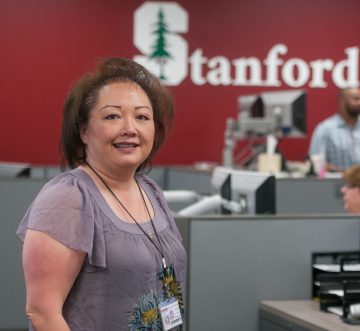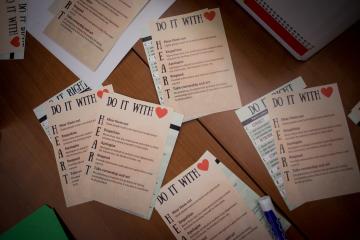University IT Focuses on Quality Service for Stanford
When we pick up the phone to get help from a call center, the interaction we have with the operator often leaves us with a lasting impression of the entire organization — for better or for worse.
 OSC Manager, Pam Miller.
OSC Manager, Pam Miller.
As the manager of University IT’s Operator Services Center (OSC), Pam Miller knows the importance of delivering excellent customer service in each one of the 3,000 phone calls her operators handle every day. That’s why she enlisted the expertise of University IT’s (UIT’s) Service Design team, who helped her create a customized training to re-engage her staff with what it means to provide quality service to callers.
“I wanted to create something like this for a long time,” Pam said. “The operators are a front door to the university and both hospitals, and the impression we set for the caller will dictate our relationship with them in the future.”
Developing empathy through discussion and role-playing
The Service Design team serves UIT and the broader Stanford community by partnering with UIT teams to improve client experiences and help teams design services with the end-user in mind. Partnering with Pam and OSC Telecom Attendant Aaron Owens, the team designed and facilitated a scalable, customized training program for OSC staff that focused on reinforcing the practices and mindsets central to delivering quality service to callers.
Service Designer Jo-Ann Cuevas facilitates a role-playing activity during one of the OSC workshops.
A total of six workshops were delivered over a two-week period, engaging OSC operators in discussion on what quality service means to them and how they might develop deeper empathy for their callers.
These discussions were then put into practice through a series of role-playing activities that encouraged open discussion and feedback on how operators might tweak their approach to more deeply empathize with their callers.
“There are always different ways of handling the calls we get,” said Penny Triburzi, telecom attendant. “Sometimes there are difficult callers, and we have to turn the situation around to make them feel more at ease. It’s great to develop strategies that can help in those situations and still allow us to do our jobs efficiently.”
The sessions also sought feedback from team members on how they might improve their current quality monitoring system.
Keeping the momentum going
 Created by the Service Design team, these visual cues help keep customer service strategies top of mind for OSC staff.
Created by the Service Design team, these visual cues help keep customer service strategies top of mind for OSC staff.
Throughout the workshop, the Service Design team captured extensive feedback from OSC operators, which will be synthesized and shared in a report. This will help ensure that the voices of operators are central to shaping OSC’s definition of quality service and future process improvements.
By further equipping operators with tangible techniques, practices, and mindsets to apply in their day-to-day interactions with callers, the Service Design team hopes the workshops contribute to the ongoing development of an empathetic, human-centered culture within the Operator Services Center that benefits the Stanford community at large.
DISCLAIMER: UIT News is accurate on the publication date. We do not update information in past news items. We do make every effort to keep our service information pages up-to-date. Please search our service pages at uit.stanford.edu/search.



